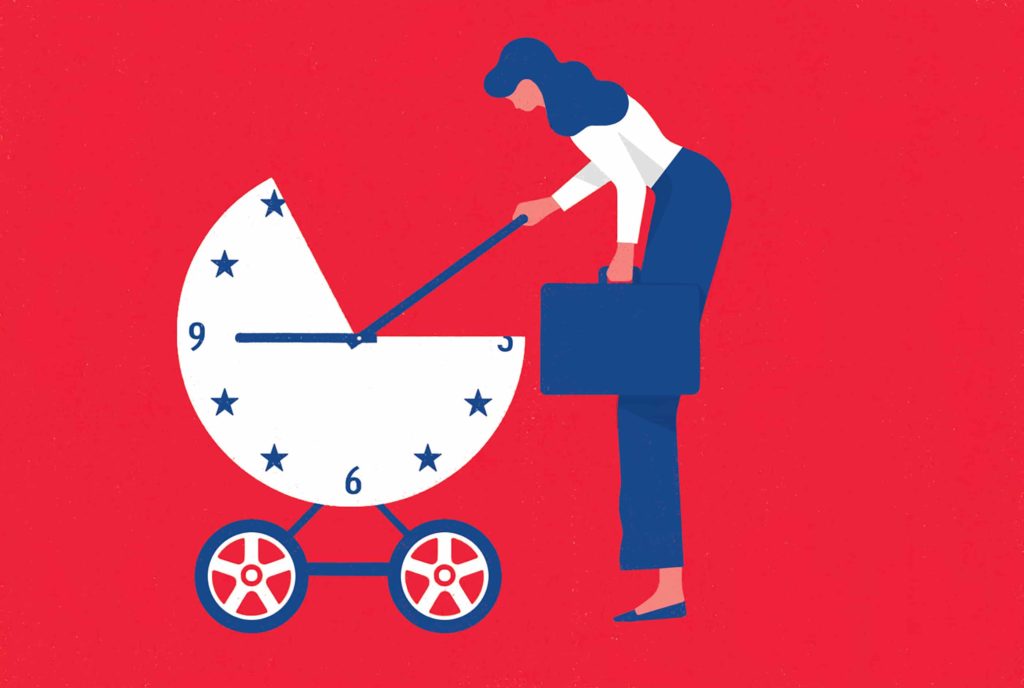Bringing a child into this world is the biggest joy for a parent. But it also comes with a set of complex responsibilities, which are best managed with some time off.
The American Journal for Public Health analyzed the trends of average maternity leave sanctioned in the United States. They found that it remained majorly unchanged for twenty-one years from 1994 to 2015. Even after some state laws permitted paid maternity leave, there was no change in trends on the national level. The lack of federal US maternity leave laws and the reluctance of women to take advantage of existing facilities were the main reasons.
This article explores FMLA laws in detail. It also answers questions regarding paid time off during maternity leaves, length of maternity leaves, and much more.
What Is Maternity Leave?
Parents require substantial time off to take care of a newborn. Also known as pregnancy leave, maternity leave is a type of leave for expectant mothers to take care of their newborns. Many women who go through pregnancy or postpartum complications can use this facility to rest and recuperate. Depending on the national laws, employers and governments grant various benefits to expectant mothers around the world.
Women in the US use the facilities provided by the Family and Medical Leave Act (FMLA). It is a federal law that guarantees up to twelve weeks of unpaid leave in certain cases. However, only a certain number of employees across the nation are eligible for it.
Is Maternity Leave Mandatory?

The rules and laws permitting maternity leave vary across different countries. In the absence of formal parental leave laws in the US, FMLA guides pregnancy leave laws for approximately sixty percent of female employees. Around forty percent of women still have no law that grants them the time to heal and bond with their newborn. This happens because only selected employees in the United States can take unpaid pregnancy leaves through FMLA.
Eligible employees can use the FMLA laws for getting up to twelve weeks of leave. The law permits only twelve weeks of annual emergency leave. If someone takes it, they will not be able to get any additional leave in the remaining year. This is the reason many women avoid taking any pregnancy leave in the US.
Do You Get Paid for Maternity Leave?
As per the American College of Obstetricians and Gynaecologists, one out of four women in the US rejoins their workplace after taking just ten days or fewer for recuperating and bonding with her newborn. A study by the International Labour Organization states that only three countries in the world do not offer any paid parental leave to expectant mothers. These three countries are the United States of America, Papua New Guinea, and the Marshall Islands.
Unlike the other two countries, the US does have FMLA. Although there is a federal law in place and it offers up to twelve weeks of medical or emergency leave, is it enough?
Do women get paid during this leave?
No, women who plan to take leave for pregnancy or maternity will not get paid by their employer for the period of their leave. However, there are some ways to get paid for some days of the twelve weeks. You can talk to HR to exchange the FMLA leaves with your accumulated paid leaves for the year.
They can also apply for temporary disability in some states which we have explained in this blog on parental leave in the United States.
Also, expectant mothers in four states — New Jersey, Rhode Island, California, and New York — can get paid maternity leave in accordance with state mandates. In California, the government offers six weeks of paid maternity leave with partial payment for that tenure.
Maternity Leave Laws
If an employer threatens to fire an expectant mother from work, citing pregnancy as the reason, there are two laws that can protect them.
- FMLA: If eligible, women can protect their jobs by taking up to twelve weeks of annual absence through this Act. Although the law does not have a provision of paid pregnancy leave, it guarantees job security for expecting mothers.
- Pregnancy Discrimination: Under the Pregnancy Discrimination Act, it is illegal to fire a pregnant worker. Employers cannot force women to take compulsory pregnancy leave, and they must grant the regular health and disease benefits to such women as offered to other employees.
If a woman loses her job because of any other reason during her pregnancy, the federal benefits for unemployed pregnant women will remain applicable in the form of unemployment benefits. However, if they choose to resign from their job during pregnancy, these benefits will not apply. The state will provide unemployment benefits only if expectant mothers are available to work.
How Does Maternity Leave Work?
Legally, no expectant mother in the United States needs to disclose her pregnancy if her condition does not affect her availability and productivity. Many women choose to continue working without disclosing their pregnancy because they can continue to work without any hindrance. If you’re physically and emotionally fit to work during pregnancy, it isn’t mandatory for your employer to know about your pregnancy.
For instance, if you need to lift weights during your working hours, and you are unable to do so, it means that your body is unfit to perform that work. In that case, you must disclose your pregnancy to the employer. This would give them a chance to arrange for federal maternity leave according to the FMLA or a paid maternity leave, according to company policy.
Does Short-Term Disability Cover Maternity Leave?
Pregnancy leave and short-term disability leave are the same for an employer. You can benefit from pregnancy disability leave because the inability to work due to pregnancy also comes under physical disability. The health benefits and work compensations that your employer provides for short-term disability, also known as short-term disability insurance, could cover a significant part of your average income when you take pregnancy leave.
In the US, one of the most common short-term disabilities among women is pregnancy. To benefit from this, you must disclose your pregnancy to your employer and ask them for the benefits. If you have privately signed up and paid for short-term disability insurance, contact your insurance provider after taking FMLA.
When to Start Maternity Leave?
If you have been experiencing pregnancy complications, it will be better if you consult with your doctor. If the complications increase, you can request your leave starting for the last month of your pregnancy. Many women use their accrued leaves to get paid maternity leave before childbirth. Once the newborn arrives, they use the twelve weeks provided under the FMLA for bonding with their child.
As 40% of women in the United States are not eligible for pregnancy leave through FMLA. They get back to work right after childbirth even if they are facing postpartum complications. By providing pregnancy leaves, an employer takes care of the employee’s well-being, increasing their productivity after they resume work.
What Is the Duration of Maternity Leave?
As the federal laws have no provision for pregnancy leave, only some state laws can provide an answer to this question. The period of pregnancy leave may vary significantly across different states, depending on the state guidelines.
Another factor determining the leave duration is your employer’s leave policies. If your company offers the benefit of pregnancy leave, the employer will notify you regarding the duration of maternity leave. Some companies provide a percentage of the employee’s salary during pregnancy leave, while others guarantee job safety with unpaid leave.
Many multinational companies (MNCs) in the US have compensated for the lack of explicit maternity holidays by providing additional benefits for their employees. PepsiCo partnered with Cleo to recognize the struggles of a mother and for supporting her psychologically and emotionally during maternity. An employee can consult with Cleo guides, attend live workshops, talk to an expert individually, access evidence-based content, and join group sessions to address their concerns.
Other companies like Nestle, Spotify, L’Oréal, and Vodafone offer paid pregnancy leave to all their employees for varying durations. During a survey conducted by a global HR consulting firm, twelve percent of one thousand two hundred global companies in the US spoke about considering a global paid leave policy.
Can You File for Unemployment While on Maternity Leave?
There are several unemployment benefits offered by the federal government to employees in need. Pregnant women are eligible to receive the benefits of this scheme if they meet specific criteria as listed below:
- Their employers forced them to quit their jobs.
- They are eligible and available to work at another place.
Under this program, the government pays you a portion of your salary as an unemployment benefit if your company shuts down unexpectedly or your employer fires you for any reason. If you lose your job during pregnancy while being physically incapable of working somewhere else, you cannot get the benefits.
How to Apply for for Maternity Leave?
You can apply for leave under FMLA for the reasons listed below:
- If you have a serious health condition that is affecting your work
- To look after a close relative or family member with severe health conditions
- Birth of a child
- Adopting a child
This law applies to all public agencies and companies with over 49 employees. The law guarantees up to 12 weeks of unpaid leave in a year to employees for balancing their work and private life.
Listed below are the eligibility conditions for getting an FMLA-approved leave:
- The employee has worked at the current company for at least twelve months
- The employee works at a company that employs fifty people or more within a radius of seventy-five miles
You must notify your employer at least thirty days before taking an FMLA leave. It is essential to mention your reason so that the employer mentions it as an FMLA condition. After following the procedures, you are eligible to take the pregnancy leave. In case of emergencies, you must inform your employer regarding your condition as soon as possible.
State-Wise Maternity Leave
In 2021, only four states in the US have a specific maternity leave law.
California Maternity Leave Law
Employers in California pay up to seventy percent of their wages with a maximum limit of $1,300 a week to female employees. Parents of newborns with more than $300 income in the previous financial year are eligible for it.
New Jersey Maternity Leave Law
New Jersey has its own family leave law and provides paid pregnancy leave. The state government pays up to $881 every week.
New York Maternity Leave Law
Beyond FMLA, New York asks private companies to grant up to ten weeks of unpaid maternity leave funded from the payroll deductions.
Rhode Island Maternity Leave Law
In Rhode Island, any company with more than fifty employees is compelled to offer up to thirteen weeks of pregnancy leave. This leave is funded by employee wage deductions.
Advantages of Maternity Leave

There are many advantages of maternity leave. Some are listed below:
- A woman is liberated from the choice between her career and family.
- Without worrying about job security, the woman will get some time to bond with her baby.
- The parent will perform with better enthusiasm and productivity after getting adequate rest.
- Women feel included and considered in the workspace, leading to increased productivity.
- Additional benefits like the support and guidance from Cleo Guides at PepsiCo or the global policy of paid pregnancy leave at Spotify show their concern and respect for the overall well-being of their female employees.
Despite the lack of maternity leave laws in the US, many women have adapted to the circumstances by using their accrued paid leaves and FMLA. But that doesn’t mean that this is the right choice to make for the government. Although some large companies are doing their part by offering paid maternity leave, the government needs to madate it on a federal level.
Women are a key part of the workforce and pregnancy is a choice that many women make. Simply providing maternity leave may not be enough. An employee may face some discomfort after getting back. Employers must try to provide flexible rest periods and childcare facilities for improved employee engagement.




